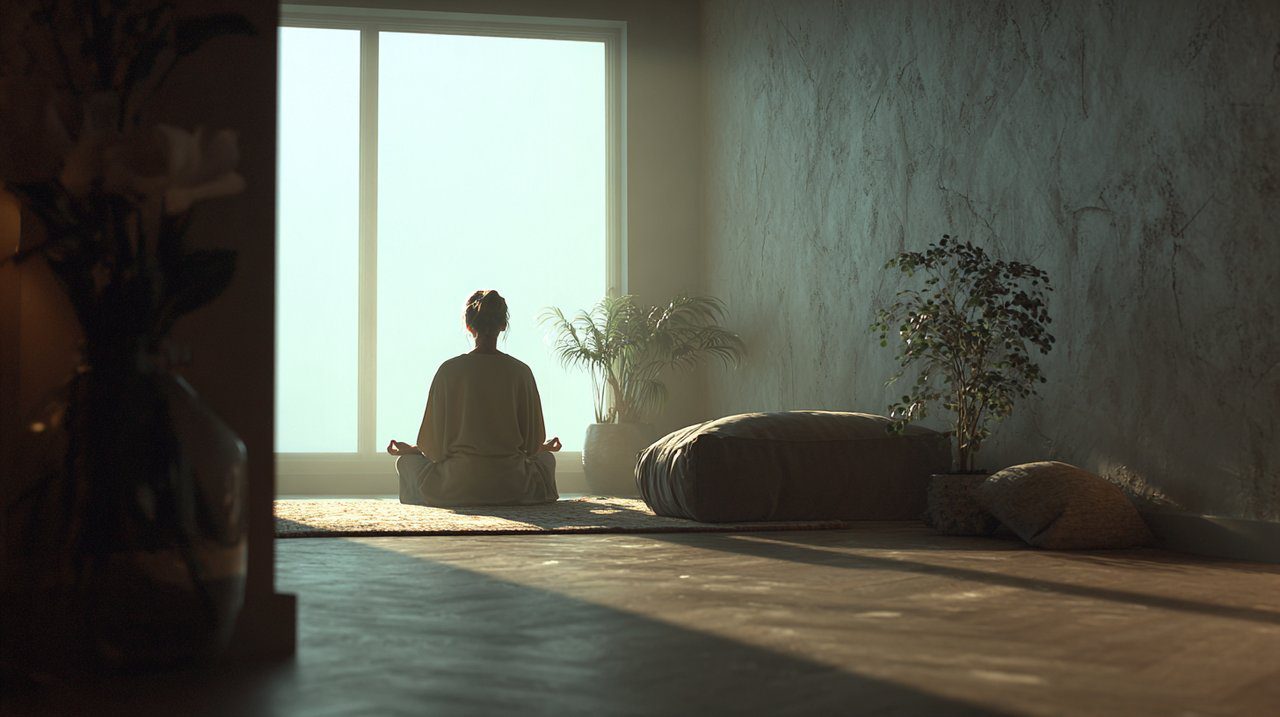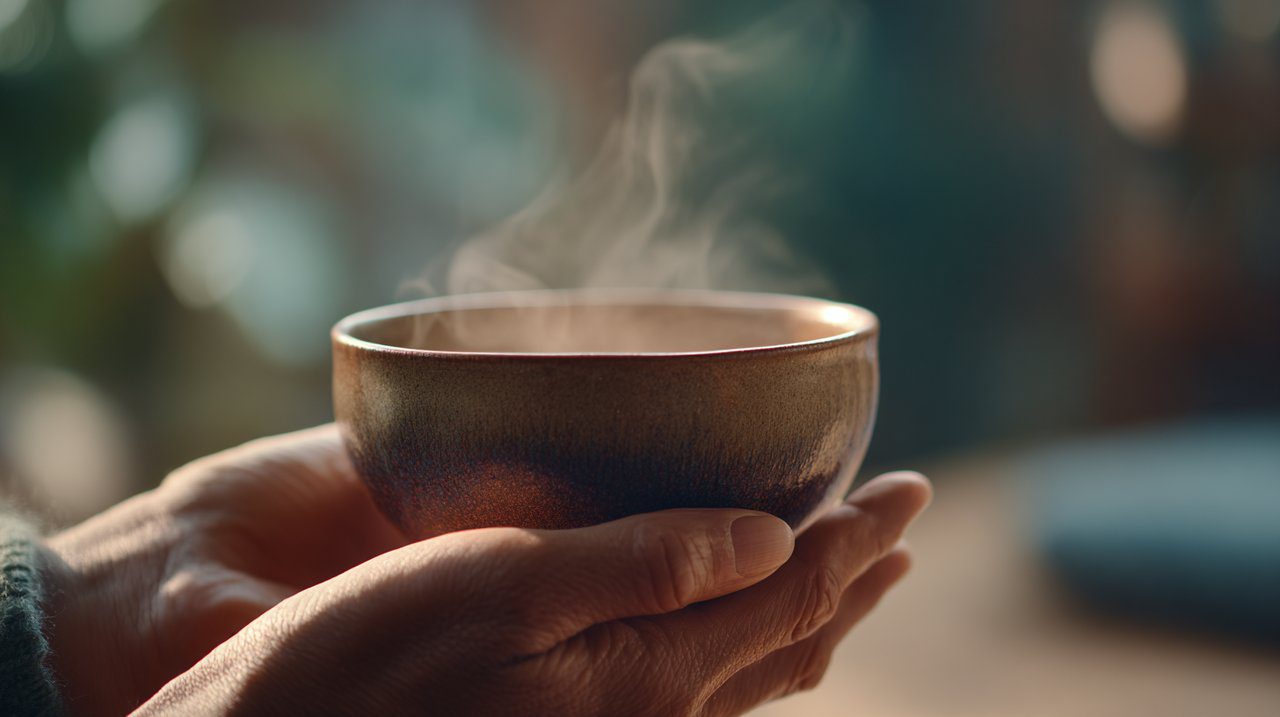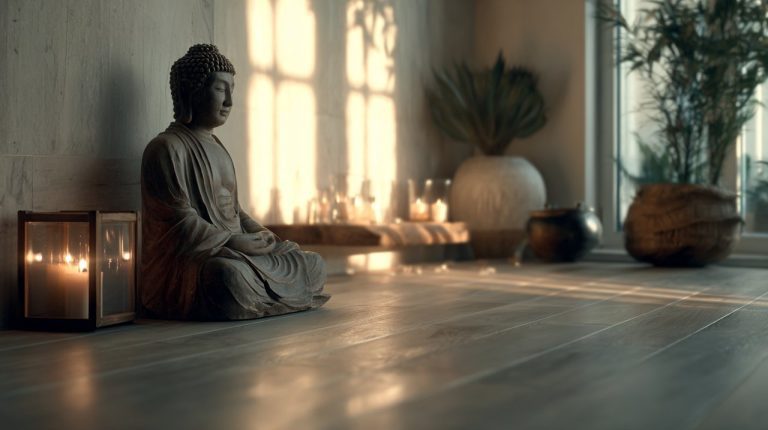How to Practice Just Sitting: 7 Simple Steps to Cultivate Inner Calm & Mindfulness
In a world that constantly calls for our attention, many of us quietly long for a deeper sense of peace and a quiet sanctuary within. This journey, which we call The Art of Conscious Stillness: Cultivating Presence Through Sacred Simplicity, offers a gentle invitation to find just that.
It’s a path to transforming the ordinary moments of your day into profound opportunities for inner calm. The practice of Just Sitting, or *shikantaza*, isn’t about achieving a specific state. Instead, it’s about simply being present with whatever is unfolding, right here, right now.
Through these seven simple steps, we will explore how to cultivate inner calm and mindfulness, weaving tranquility into the very fabric of your existence.
Setting the Stage: The Sacred Space of Stillness
To begin your just sitting meditation, it can be wonderfully helpful to designate a specific area for your practice. This isn’t about grand gestures or elaborate setups; it’s about creating an environment that quietly signals to your mind, “This is a time for presence.”
Even a small corner of a room can become your sanctuary. Take a moment to clear away any clutter that might pull at your attention, allowing the space to feel open and inviting. You might place a comfortable cushion or chair, perhaps a simple, natural object like a smooth stone or a small plant.
This act of thoughtful preparation is a micro-ritual in itself. It signals a deep respect for your intention and the stillness you seek. Consider a quiet window sill bathed in morning light, or a specific armchair where you always return.
Over time, this dedicated spot will hold the energetic imprint of your practice, becoming a powerful anchor for your inner calm.

The Anchor of the Body: Finding Your Seat with Intention
The physical posture during just sitting is not about rigidity, but about finding a harmonious balance between alertness and ease. Your body becomes your primary anchor, gently grounding your awareness in the present moment.
An upright posture allows your breath to flow freely and your mind to remain clear. When your spine is gently aligned, it cultivates a sense of dignity and inner strength. This physical stability directly supports mental tranquility, making it a foundational mindfulness sitting technique.
Find a comfortable position, whether cross-legged on a cushion or seated in a chair with your feet flat on the floor. Allow your shoulders to relax, your hands to rest gently on your lap, and your gaze to soften downwards, or your eyes to gently close.
Feel the quiet connection of your body to the earth beneath you, a silent affirmation of your presence, right here, right now.
Breath as a Gentle Current: Allowing Rather Than Controlling
Once you are settled, bring your awareness to your breath. This step in just sitting is not about manipulating or controlling your breath; it’s simply about observing it as it is.
Your breath is a constant, subtle current, always present and always in the now. It serves as a reliable guide back to the present moment, requiring no effort, only gentle observation. Noticing the natural rhythm of inhalation and exhalation provides a gentle, accessible anchor for your attention.
A common misconception is the need to breathe in a specific way—deeper, slower, or more rhythmically. This attempt to control can inadvertently create tension. Instead, simply allow your breath to be as it is, without judgment or interference.
Notice the sensation of the air entering and leaving your body, perhaps at your nostrils, your chest, or your abdomen. Just feel it.
The Unseen Altar: How Your Everyday Space Becomes a Sacred Sanctuary for Stillness
Beyond a designated meditation spot, just sitting invites us to see our entire environment, even the most mundane, as an extension of our sacred practice. This is about infusing reverence into the ordinary, transforming your daily space into an unseen altar for stillness.
Our environment profoundly influences our inner landscape. By bringing conscious awareness and respect to the objects and spaces around us, we elevate their purpose. A simple cup of tea, a well-worn wooden table, or the view from a window can become powerful anchors for just sitting meditation when approached with intention.
Consider a moment of quiet gratitude for the warmth of your mug, the solid presence of your chair, or the gentle light filtering through the window. These are not merely props, but silent companions in your quest for presence.
They are gentle reminders that the sacred is not distant, but intimately interwoven with the fabric of your daily life.
“The ordinary is the miraculous.” – Thich Nhat Hanh
Meeting Thoughts with Openness: The Sky and the Clouds
During just sitting, thoughts will inevitably arise. The practice here is not to stop thinking, but to observe thoughts without getting entangled in their narratives. When thoughts appear, simply acknowledge their presence without judgment.
Rather than chasing them or pushing them away, allow them to simply be. You might gently label them – “thinking,” “planning,” “remembering” – and then release them without engagement. This cultivates a spacious awareness where thoughts can come and go.
Imagine your awareness as the vast, boundless sky, and your thoughts as passing clouds. Some clouds may be light and airy, others dark and dense, but the sky itself remains unaffected, always present, always clear.
This perspective helps us to gently detach from the content of thoughts, allowing them to drift by without taking hold.

Returning to the Present: A Gentle Re-anchoring
Distraction is a natural and expected part of any mindfulness sitting technique. The true practice lies not in avoiding distraction, but in the gentle act of returning your attention when it wanders.
When you notice your mind has drifted, simply acknowledge where it has gone without judgment. Then, with a soft resolve, gently guide your attention back to your primary anchor – whether it’s the breath, the sensations of your body, or the sounds around you.
Each moment of returning is a fresh opportunity to cultivate presence. A common misconception is that experiencing distraction means you are failing at the practice. On the contrary, each time you notice your mind has wandered and gently bring it back, you are strengthening your muscle of awareness.
There is no need for frustration; each return is an act of compassion towards yourself, a quiet moment of re-anchoring.
The Echo of Stillness: Carrying Calm into Your Day
Just sitting is not an isolated event; it is a practice designed to resonate throughout your entire day. The true art lies in carrying the qualities of stillness and presence into your everyday actions.
The benefits of your formal just sitting meditation extend far beyond the cushion. By consciously integrating moments of mindfulness into your routine, you begin to transform your entire experience of life. This cultivates a sustained sense of inner calm and clarity, making daily life itself a living practice.
As you conclude your sitting, take a moment to acknowledge the stillness you have cultivated. Then, gently rise and bring this quality of awareness to your next action. Whether you are drinking a cup of tea, walking across a room, or listening to a loved one, approach it with the same quiet attention you brought to your sitting.
These micro-rituals of mindful engagement allow the echo of stillness to ripple through your entire day. They are how we discover that the profound peace we seek is already within us, waiting to emerge.

Just sitting is the art of simply being, allowing that profound peace to emerge. It is not about reaching for something distant, but about discovering the sacred in the immediate. By embracing these simple steps, you cultivate a deep well of inner calm and mindfulness.
Choose one step that resonates with you today and begin your journey. The path to presence is always here, waiting for your gentle attention, ready to transform your ordinary moments into something truly sacred.
💡 Häufig gestellte Fragen
Just Sitting, also known as shikantaza, is a form of meditation that focuses on simply being present with whatever is unfolding, without trying to achieve a specific state. Unlike some mindfulness techniques that involve focusing on a particular object like the breath, shikantaza emphasizes open awareness and accepting all experiences without judgment. The goal is not to stop thoughts, but to observe them as they arise and pass.
To create a sacred space for Just Sitting, designate a specific, quiet area for your practice. This doesn't require grand gestures; simply clear away clutter to make the space feel open. You can add a comfortable cushion or chair, and perhaps a small, natural object like a plant. This thoughtful preparation signals to your mind that it's time for presence and helps create an anchor for your practice.
The recommended posture for Just Sitting is one that balances alertness and ease, with an upright spine. This alignment allows for free-flowing breath and a clear mind, cultivating a sense of dignity and inner strength. Whether sitting cross-legged on a cushion or in a chair with feet flat, the aim is to feel grounded and present, with relaxed shoulders and hands resting gently.
During Just Sitting, the practice concerning the breath is to observe it gently rather than control it. Simply allow your breath to be as it is, noticing the natural rhythm of inhalation and exhalation without judgment or interference. This natural current serves as a reliable, effortless anchor back to the present moment.
The 'sky and the clouds' analogy illustrates how to approach thoughts during Just Sitting. Your awareness is the vast, boundless sky, and your thoughts are like passing clouds. The practice is to acknowledge thoughts without getting entangled in them, neither chasing nor pushing them away. You can gently label them ('thinking') and then release them, allowing them to drift by without taking hold, just as clouds don't affect the sky.







